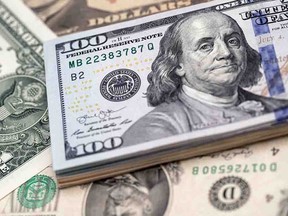
Article content
Investor jitters over a weakening U.S. dollar, rising government debt and central bank monetary policy have fuelled discussion and debate on Wall Street about what JPMorgan Chase & Co. analysts coined “the debasement trade.” Here, the Financial Post explains what it means and how investors can protect their money.
THIS CONTENT IS RESERVED FOR SUBSCRIBERS ONLY
Subscribe now to read the latest news in your city and across Canada.
- Exclusive articles from Barbara Shecter, Joe O'Connor, Gabriel Friedman, and others.
- Daily content from Financial Times, the world's leading global business publication.
- Unlimited online access to read articles from Financial Post, National Post and 15 news sites across Canada with one account.
- National Post ePaper, an electronic replica of the print edition to view on any device, share and comment on.
- Daily puzzles, including the New York Times Crossword.
SUBSCRIBE TO UNLOCK MORE ARTICLES
Subscribe now to read the latest news in your city and across Canada.
- Exclusive articles from Barbara Shecter, Joe O'Connor, Gabriel Friedman and others.
- Daily content from Financial Times, the world's leading global business publication.
- Unlimited online access to read articles from Financial Post, National Post and 15 news sites across Canada with one account.
- National Post ePaper, an electronic replica of the print edition to view on any device, share and comment on.
- Daily puzzles, including the New York Times Crossword.
REGISTER / SIGN IN TO UNLOCK MORE ARTICLES
Create an account or sign in to continue with your reading experience.
- Access articles from across Canada with one account.
- Share your thoughts and join the conversation in the comments.
- Enjoy additional articles per month.
- Get email updates from your favourite authors.
THIS ARTICLE IS FREE TO READ REGISTER TO UNLOCK.
Create an account or sign in to continue with your reading experience.
- Access articles from across Canada with one account
- Share your thoughts and join the conversation in the comments
- Enjoy additional articles per month
- Get email updates from your favourite authors
Sign In or Create an Account
or
Article content
What is the debasement trade?
Article content
Article content
In a nutshell, the trade is a reaction to the belief that inflation, deepening government deficits and monetary easing by central banks are devaluing traditional fiat currencies and sovereign bonds.
Article content
Article content
Fearing that purchasing power is disintegrating before their eyes, some investors are parking their cash in assets untethered to dilution, such as gold, silver and other precious metals, stocks, real estate and cryptocurrency.
Article content
By signing up you consent to receive the above newsletter from Postmedia Network Inc.
Article content
“The value of the U.S. dollar in regard to what it’s able to purchase has become steadily worse since the 2008 financial crisis,” said Martin Pelletier, senior portfolio manager at Wellington-Altus Private Counsel. “As the de-dollarization accelerates, investors bid up hard assets, and those hard assets go up in value.”
Article content
Gold, the safe-haven poster child that investors turn to as a hedge against economic uncertainty, is a prime example. The precious metal’s spot price hit an all-time high of US$4,381 per ounce in October before pulling back. It has risen more than 60 per cent over the last year and is on track for its “strongest performance in a calendar year since 1979,” according to the World Gold Council. Prices for silver, platinum and palladium have also spiked.
Article content
Central banks are a driving force behind gold’s meteoric rise, having beefed up their reserves to over 1,000 tonnes annually over the last three years — from an average of 400 to 500 tonnes annually in the previous decade, according to the council’s 2025 central bank gold reserves survey.
Article content
Article content
“They’re consistently buying because they see what’s going on,” said Paul Wong, market strategist at Sprott Asset Management. “Think of central banks as the ultimate insider for the U.S. dollar and fiat assets. They see the dilutions and they have front row seats to all this.”
Article content
Article content
When did it originate?
Article content
Examples of governments debasing currencies to fund spending date back to the Roman Empire, when Nero set a precedent by gradually reducing the content and purity of gold and silver in coins. King Henry VIII made similar moves between 1544 and 1551, a period known as “the great debasement.”
Article content
Wong said the debasement trade has been happening “forever” and goes through phases. In a report, he noted that the price of gold rose from US$35 per ounce in 1971 to more than US$800 per ounce by 1980 as “loose fiscal and monetary policy, combined with the oil shocks of 1973 and 1979, drove inflation sharply higher, weakened the U.S. dollar and contributed to an extended period of stagflation.”
Article content
That period “established the foundational precedent for modern hard asset investing in environments characterized by currency debasement and inflationary pressure,” he said.

.jpg) 1 hour ago
1
1 hour ago
1
 English (US)
English (US)